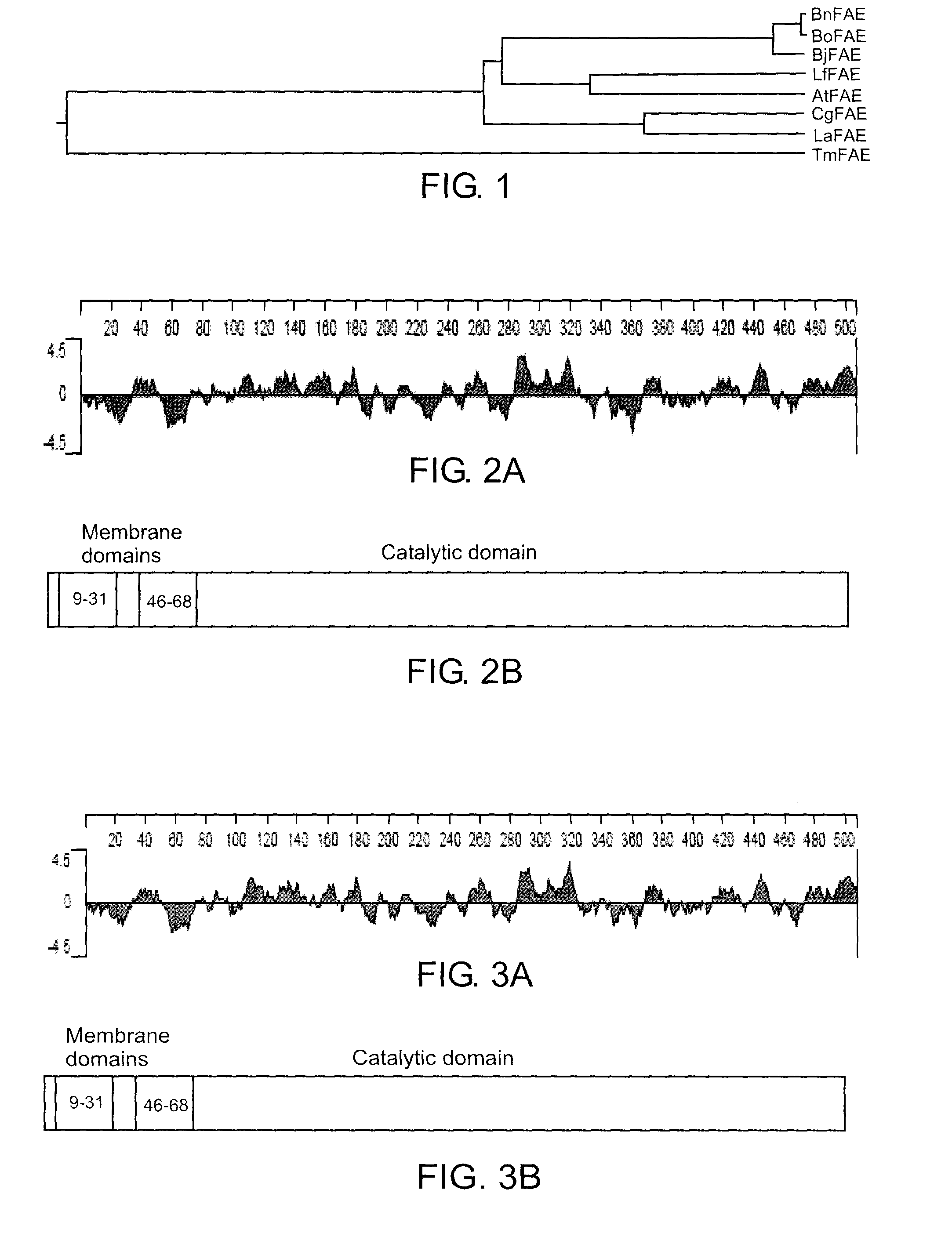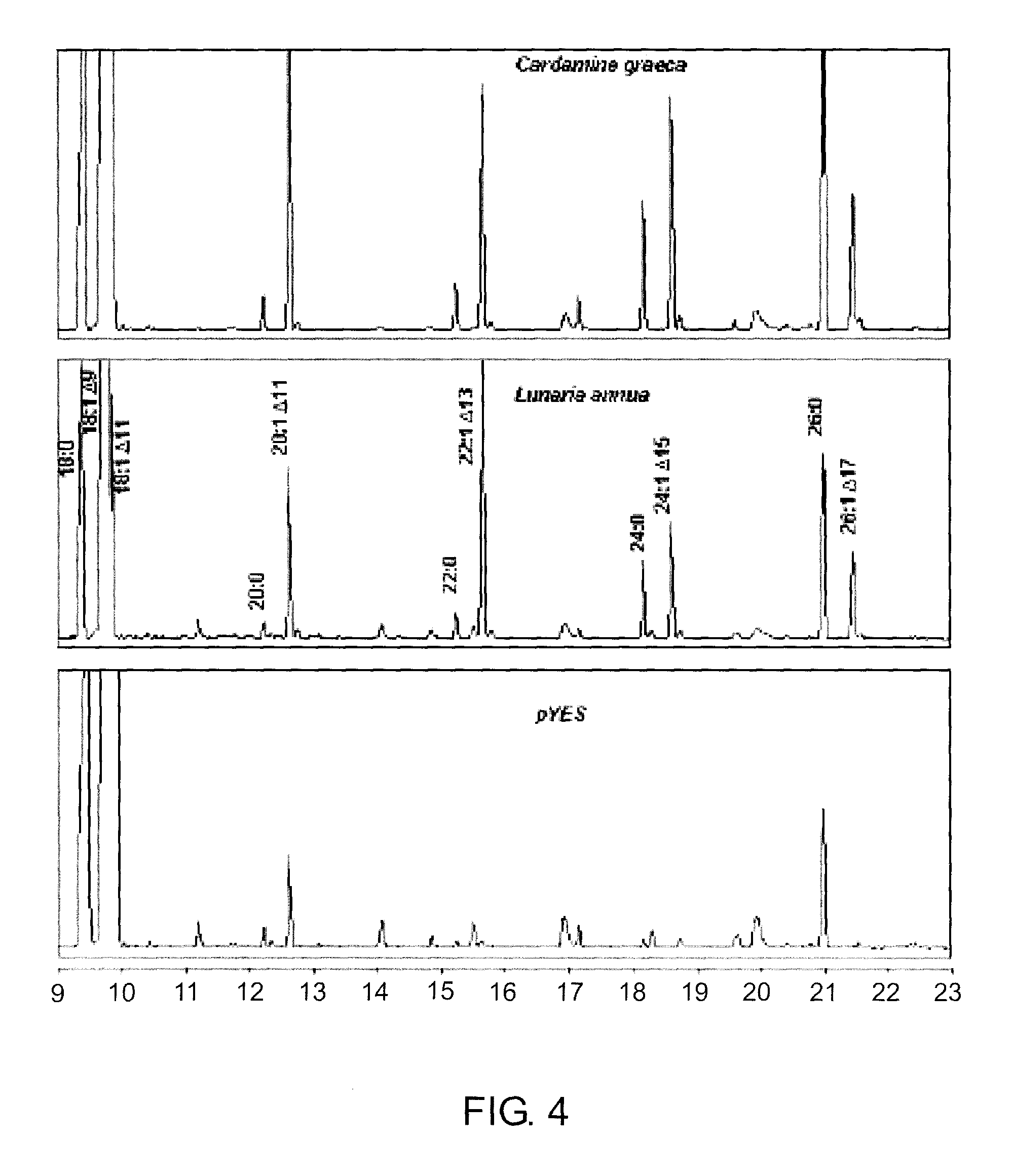Lunaria annua,cardamine graeca and teesdalia nudicaulis fae genes and their use in producing nervonic and eicosenoic acids in seed oils
a technology seed oil, which is applied in the field of fatty acid elongase (fae) genes, can solve the problems of seed shattering, uneconomical cultivation of l. annua, and considerable effort will still be required to develop this crop, so as to increase the level of nervonic acid, increase the level of eicosenoic acid, and increase the level of vlcmfa
- Summary
- Abstract
- Description
- Claims
- Application Information
AI Technical Summary
Benefits of technology
Problems solved by technology
Method used
Image
Examples
example 1
Plant Materials
[0048]Lunaria annua, Cardamine graeca and Teesdalia nudicaulis plants were grown in the greenhouse at the Kristjanson Biotechnology Complex Greenhouses, Saskatoon, under natural light conditions supplemented with high-pressure sodium lamps with a 16 h photoperiod (16 h of light and 8 h of darkness) at 22° C. and a relative humidity of 25 to 30%. Seeds at the mid-developing stage were harvested, frozen in liquid nitrogen and stored at −80° C. until used for genomic DNA isolation. Mature seeds were harvested and used for GC analyses of fatty acid composition of seed lipids.
Heterologous Expression of FAE Polypeptides in Yeast
[0049]Yeast cells (line Inv Sc1, Invitrogen) were transformed with pYES2.1 / V5-His-TOPO constructs bearing different FAE cDNAs, using the S.c. EasyComp™ Transformation Kit (Invitrogen). As a control in the expression experiments, yeast cells were transformed with pYES2.1 / V5-His-TOPO plasmid-only. Transformants were selected by growth on synthetic comp...
example 2
Composition of L. annua or C. graeca Seed Lipids
[0058]The acyl composition of the TAG fraction of L. annua and C. graeca had highly enriched proportions of very long chain monounsaturated fatty acids (VLCMFAs) with 36% erucic acid (22:1 Δ13) and 25% nervonic acid (24:1 Δ15) in L. annua plant seed oil while C. graeca had 10% erucic acid and 43% nervonic acid in the seed oil.
example 3
Isolation of L. annua and C. graeca FAE Homologs
[0059]Based on sequence homology among plant fatty acid elongase genes, full-length clones were amplified by PCR as in Example 1. The nucleotide sequences had open reading frame of 1518 and 1521 bp, respectively (SEQ ID NO: 5 and 6).
[0060]The analysis of the nucleotide sequence corresponding to L. annua and C. graeca FAE genomic clones revealed the absence of intron sequences. A similar absence of introns was observed in homologs from A. thaliana FAE1, rapeseed CE7 and CE8 and high and low erucic lines of B. oleracea, B. rapa, canola B. napus cv Westar and HEAR B. napus cv Hero and T. majus.
[0061]The L. annua and C. graeca FAE nucleotide sequences encode polypeptides of 506 and 507 amino acids (SEQ ID NO: 7 and 8), respectively. The L. annua and C. graeca FAE protein were predicted to have a molecular mass of 56.06 kD and 56.46 kD, respectively.
[0062]L. annua plant FAE polypeptide is most closely related to B. juncea and A. thaliana F...
PUM
| Property | Measurement | Unit |
|---|---|---|
| Level | aaaaa | aaaaa |
Abstract
Description
Claims
Application Information
 Login to View More
Login to View More - R&D
- Intellectual Property
- Life Sciences
- Materials
- Tech Scout
- Unparalleled Data Quality
- Higher Quality Content
- 60% Fewer Hallucinations
Browse by: Latest US Patents, China's latest patents, Technical Efficacy Thesaurus, Application Domain, Technology Topic, Popular Technical Reports.
© 2025 PatSnap. All rights reserved.Legal|Privacy policy|Modern Slavery Act Transparency Statement|Sitemap|About US| Contact US: help@patsnap.com



